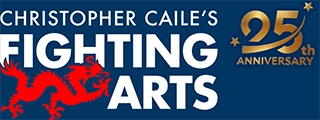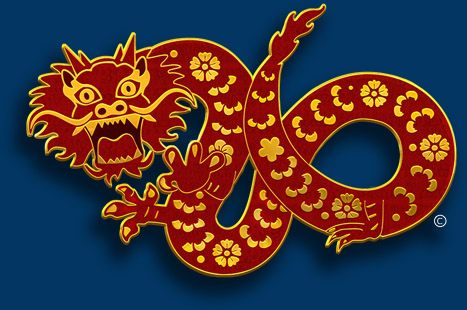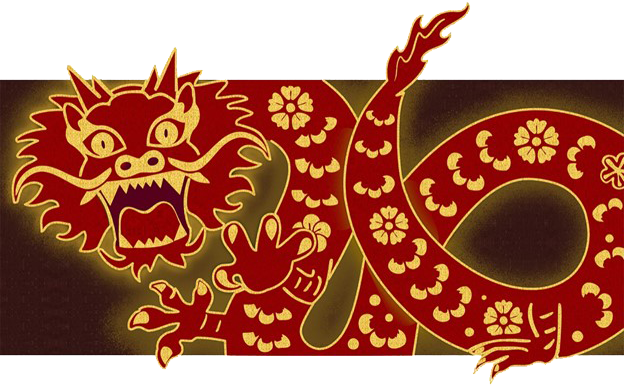The Way Of The Scout
Seeing The World In Single Imprint
By Christopher Caile
Editor's Note: FightingArts.com was invited to interview Tom Brown, Jr. as part of Paramount Picture's promotion of the film, "The Hunted." Brown helped inspire the film and worked as a technical on it. A second related article is a review of "The Hunted."
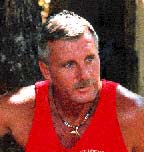
Few who meet him casually would guess how unique this man is. Brown is a modern American with Ninjitsu camouflage and survivalist skills. He may just be a prototype for a new generation of action hero.
Just as the world's greatest detective, Sherlock Holmes, was inspired in the 1880's by the phenomenal powers of observation of the real-life physician Dr. Bell, Brown's skills served as the inspiration for new Paramount Studios film "The Hunted."
Sitting there, talking with me in a hotel room, I could see a vague disquiet. He is not at home in the city. His fingers play across his knees. He is much more at home in the wilderness with trees and sky as company.
Brown is the protégé of an old Indian scout and tracker. He can sense the wilderness, see and hear the imprint of life and movement all around him. There is an old adage that says, "The real secret of life is seeing what you see." When Brown first introduces someone to the outdoors he asks them to look closely at the ground because after his training they will never see the ground the same again.
This total perception reminds me of Valentine Michael Smith in the science fiction tale "Stranger In A Strange Land." An orphaned prodigy of the first manned expedition to Mars, Smith is raised by Martians before being returned to earth. The way he experienced things was by "Groking" – that is, becoming one with them. No less can be said of Brown's understanding of the wilderness. He has learned to be one with the nature he understands.
It was Brown who served as the first inspiration for "The Hunted." When William Friedkin, director of such films as "The Exorcist", "To Live And Die In LA" and "The French Connection," first met Brown, he was fascinated by the man and his skills. He wanted to make a film about them, but couldn't figure out a way to portray Brown within a story context. Then Friedkin read a script about a Delta Force style guy who becomes a serial killer. This provided a story line, and Friedkin used Brown as the prototype for Tommy Lee Jones, who portrays L.T. Bonham in the movie.
Part of the plot line is borrowed right out of Brown's life: the hero Bonham, like Brown, was a former trainer of Navy Seals and Delta Force personnel — someone who had never killed, but who taught his students how to make their way almost invisibly through enemy territory, how to survive, to track and to return safely. When Friedkin decided to make the movie, he recruited Brown as a consultant. Brown in turn helped create the reality that both Tommy Lee Jones and Benicio Del Toro portray.
In "The Hunted" Bonham is recruited by the FBI to track and help find a gruesome murderer in the wilds of Oregon – a former military student (Aaron Hallam played by Benicio Del Toro) who has gone off the deep end.
In one of the first scenes, Bonham tracks a wounded wolf across the snowy wilds to remove a snare, and he uses a poultice of a local plant to heal the wound. "Of course, in reality it would have taken two to three weeks to gain the wolf's confidence," admitted Brown. In the movie the reality was truncated and used to introduce Bonham both as a protector of wildlife as well as a man with unique tracking skills.
Brown's skills were developed over decades. His teaching started early. He was brought up in southern New Jersey and loved the woods and outdoors. At the age of seven, Brown was befriended by an 83 year old Apache man named Stalking Wolf, who he called Grandfather. It was someone who would change his life – a real life shaman guide like don Juan Matus, the Mexican Indian teacher who figured in Carlos Castaneda's book series.
Over the next eleven years Grandfather taught Brown tracking, survival, awareness and other ancient Apache skills. He learned to survive without bringing anything for survival; how to live in harmony with nature; and how to blend in so as not to be seen. He also learned to read various animal trails, runs, beds and feeding areas and how to track and trap them. Grandfather taught that the earth was like an open book that could be read.
"We (Brown and his friend Rick) would be out in the woods collecting wood and suddenly he (Grandfather) would appear out of nowhere and ask us 'where is the nearest hawk? Where the nearest fox?' and he expected us to know. He was a town crier in defining things to be aware of – everything."
Most people have a pinpoint focus, explained Brown. What Grandfather taught him was to have a wide-angle, expanded vision, to develop sound awareness and not to let his senses follow his eyes. "People are great filtering devices," Brown explains. "They go into a room and if they think green, they will see green. It's the same with any color. In the wilderness, awareness is focus on things that are warning devices – birds, fluttering of wings, visual signs of disturbances and a host of other almost imperceptible signs."
Brown eventually founded his own Tracking School near his hometown in southern New Jersey. Brown is also the author of twelve books on wilderness survival and tracking including "The Way Of The Scout", "The Science And Art Of Tracking" and "The Tracker." That's how he makes his living now. He also provides tracking services for military and law enforcement, "but we do that for free."
The school offers a variety of wilderness courses attended by people from all over the world. "We have 30 different levels in our school. After the first week you will be able to survive anyplace," he said. A big part of this training is awareness. "In one of our scout classes we train students by suspending them on a log over water. They are blind folded against an opponent." In this position students learn to sense where the next blow will come from.
Brown's skills are phenomenal. He can see footprint in the forest, and from the imprint read the person who made it – if it is man or women, how heavy, if he or she is tired, wounded, or hungry – all signaled by minute and almost imperceptible signs. He can do the same thing indoors. In a room, notes Friedkin, Brown can get down and look at the carpet, and tell you how many people were there, how long ago and other things about them.
These tracking skills are demonstrated in one of the first scenes in the movie, as Bonham (Jones) tracks his former student Hallam (Del Toro) through the wilderness. Here the movie plot bears a loose connection with Brown's own experience. "It happened years ago," said Brown, "and I can't give you a date or where. It was when the government ended its by taking away a bad guy in another country in a desert environment — in a place neither me nor the government should have been. I got shot in the back, but this was my own fault."
"There are two worst case tracking scenarios," Brown noted. "The first is a sniper. As a tracker your attention is on the ground, you move slowly listening to sounds, listening and looking. At the same time the sniper can drop you from a distance." The second type scenario was depicted in the movie. "You are tracking someone who you trained, who knows your secrets, can counter-track and set traps. We were hoping to get that kind of tension in the movie. In the woods this could have been played to a sinister degree of tension."
"As a student, Tommy Lee Jones was a great," noted Brown. "He lives on a ranch and knows the outdoors. Benicio didn't know much about the outdoors but he was a fast learner. In the scene where he builds a fire (out of what he finds in the woods), he learned this in one hour." As for his ability to move invisibly through the woods, "he would watch me and then follow that – how to move like a shadow."

"You also move with the terrain," Brown says, "into the shadows and how they play across the ground. You move with the wind and leaves as part of the symphony of sound and motion – not faster or slower." This is what is known as moving like a shadow.
Brown's expertise was also used in the camouflage that Hallam (Del Toro) uses to disguise himself in the wilderness. "All covered in mud, charcoal and ash, his body became a canvas that reflected his surroundings," said Brown. "This disguise was so good that in the first shoot the camera couldn't find Hallam (Del Toro), so they had to reduce the camouflage so his character could be seen on film."
In real life this elusive, Ninja-type skill is what Brown taught to the Delta Forces and Navy Seals – "to move so that an adversary doesn't even know you are there." When he "found that they were also becoming much better killers," a moral dilemma developed for Brown, and he stopped teaching the military. "But after 9/11, I went back," said Brown.
In the movie Friedkin depicts a similar dilemma for Bonham but portrays it differently. "I think Friedkin found part of him to put into the movie here," said Brown. "Personally, I try to avoid close combat. I teach getting in and out without being seen. I wanted to contribute to the movie to make it authentic," said Brown. "As to the level of violence depicted, this did make me wince a bit."
In the movie, what Brown calls the "Apache-Wolverine fights" were fast and brutal – the brutality shown with blood knives that have tubes running though them so when an actor makes a cut it leaves a blood trail. For his own kids, Brown admitted that he had an edited version of the movie with the Kosovo and the final fight scenes cut out.

An important element in these knife action scenes, that took the proportion of almost an extra, was a very distinctive knife – something that Brown himself had designed as an all around wilderness tool. It is heavy on one end, almost like a mini-axe, that can be thrown, and has a serrated edge that can be used as a saw. There is also a second blade that can be used to pull along a surface to peel. "I wanted to make them available to my friends," said Brown, "so I contacted friends at TOPS Knife Manufacturing who produced an inexpensive version people could buy. It's called "Tracker." We also have a smaller version called the "Scout" and the two lock together. They are worn in a variety of ways."
In the movie this knife was used by Hallam in the first scene to kill the Serbian commander who ordered the atrocities in Kosovo, to kill hi-tech hunters in Oregon, and is seen again as the weapon fashioned out of rusting steel at the end of the movie. In the final scene Hallam is pitted against Bonham, who has fashioned his own weapon, a crude knife chipped out of flint. "In my Tracking School we teach our students to build this same flint-type knife," said Brown. "We teach them to survive with nothing."
Reflecting on the knife used by Harlem in the movie, Brown suggests that it served as a metaphor in the movie. "Hallam (Benicio) hadn't mastered the self-sufficiency of Bonham (Jones), who could make a knife out of stone. In the end, the simpler and more basic overcame the bigger, stronger and more technical. Tommy Lee's weapon was also smaller and faster."
Was he happy with the film? "Well, I will put it this way," Brown said. "I created the colors of choice for Billy Friedkin (the director), who then designed and painted the picture."
About the Author Christopher Caile
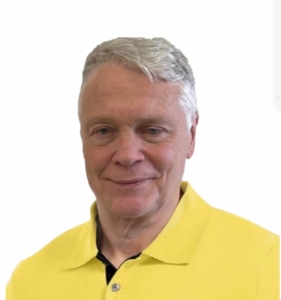
Screenshot
Christopher Caile is the Founder and Editor-In-Chief of FightingArts.com. He has been a student of the martial arts for over 65 years.
He first started in judo while in college. Then he added karate as a student of Phil Koeppel in 1959 studying Kempo and Wado-Ryu karate. He later added Shotokan Karate where he was promoted to brown belt and taught beginner classes. In 1960 while living in Finland, Caile introduced karate to that country and placed fourth in that nation's first national judo tournament.
Wanting to further his karate studies, Caile then hitch hiked from Finland to Japan traveling through Scandinavia, Europe, North Africa, the Middle East and South and Southeast Asia — living on 25 cents a day and often sleeping outside.
Arriving in Japan (1962), Caile was introduced to Mas Oyama and his fledgling full contact Kyokushinkai Karate by Donn Draeger, the famous martial artist and historian. Donn also housed him with several other senior international judo practitioners. Donn became Caile's martial arts mentor, coaching him in judo and introducing him to Shinto Muso-ryu under Takaji Shimizu.
Caile studied at Oyama's honbu dojo and also at Kenji Kurosaki's second Tokyo Kyokushinkai dojo. In his first day in class Oyama asked Caile to teach English to his chief instructor, Tadashi Nakamura. They have been friends ever since. Caile also participated in Oyama's masterwork book, "This Is Karate."
Caile left Japan with his black belt and designation as Branch Chief, the first in the US to have had extensive training in Japan directly under Oyama Sensei. As such, Oyama Sensei asked him to be his representative on visits to his US dojos to report on their status.
A little over a year later, Nakamura, Kusosaki and Akio Fujihira won an epic David vs. Goliath challenge match against Thailand's professional Muay Thai Boxers in Bangkok, Thailand, thrusting Kyolushinkai and Nakamura into national prominence.
Back in the US Caile taught Kyokushinkai karate in Peoria, Il while in college and later in Washington, DC. while in graduate school. Durimg this time Shihan Nakamura had moved to New York City to head Kyokushinkai's North American Operation.
In 1976 when Kaicho Tadashi Nakamura formed the World Seido Karate organization, Caile followed. Living then in Buffalo, NY, Caile taught Seido karate and self-defense at the State University of New York at Buffalo (SUNY Buffalo) for over 15 years where he also frequently lectured on martial arts and Zen in courses on Japanese culture.
Caile moved to New York City in 1999 to marry Jackie Veit. He is now an 8th degree black belt, Hanshi, training in Seido Karate's Westchester, NY Johshin Honzan (Spiritual Center) dojo. In Seido Caile is known for his teaching of and seminars on kata applications. He also produced a 14 segment video series on Pinan kata Bunkai currently available to Seido members.
Caile is also a long-time student and Shihan in Aikido. He studied in Buffalo, under Mike Hawley Shihan, and then under Wadokai Aikido's founder, the late Roy Suenaka (uchi deshi under Morihei Ueshiba, founder of Aikido and was Shihan under Tohei Sensei). In karate, Suenaka (8thdan) was also an in-house student of the Okinawan karate master Hohan Soken.
Having moved to New York City, Caile in 2000 founded this martial arts educational website, FightingArts.com. Twenty-five years later, in 2025, it underwent a major update and revision.
For FightingArts.com and other publications Caile wrote hundreds of articles on karate, martial arts, Japanese art, Chinese Medicine and edited a book on Zen. He also developed relationships with a cross section of leading martial arts teachers. Over the last four decades he has conducted extensive private research into karate and martial arts including private translations of the once secret Okinawan hand copied and passed on Kung Fu book, the Bubishi, as well as an early karate book by the karate master Kenwa Mabuni. He periodically returns to Japan and Okinawa to continue his studies and participate Seido karate events. In Tokyo he practiced (with Roy Suenaka Sensei) in a variety of aikido organizations with their founders – including private interviews and practices at the Aiki-kai Aikido Honbu dojo with the son and grandson of aikido's founder, Doshu (headmaster) Kisshomaru (an old uchi-deshi friend) and his son, Moriteru Ueshiba and in Iwama with Morihiro Saito. On Okinawa he studied Goju Ryu karate under Eiichi Miyazato, 10th dan founder of Naha's Jundokan, and also with Yoshitaka Taira (who later formed his own organization, who specialized in kata Bunkai. While there Caile also trained with Hohan Soken's senior student, Master Fusei Kise, 10 dan as well as with the grandson of the legendary karate master Anko Itosu.
Caile's other martial arts experience includes: Diato-ryu Aikijujitsu and Kenjitsu, kobudo, boxing, Muay Thai, MMA, Kali (empty hand, knife and bolo), study of old Okinawan Shoran-ryu & Tomari body mechanics, study of old Okinawan kata under Richard Kim, study of close quarter defense and combat, including knife and gun defenses, Kyusho Jitsu and several Chinese fighting arts including 8 Star Praying Mantis, Pak Mei (White Eyebrow), and a private family system of Kung Fu.
Caile is also a student of Zen as well as a long-term student of one branch of Traditional Chinese Medicine, Chi Kung (Qigong). As one of two senior disciples of Chi Kung master Dr. Shen (M.D., Ph.D.) Caile was certified to teach and practice. This led to Caile's founding of the The Chi Kung Healing Institute on Grand Island, NY. In Western NY, he also frequently held Chi Kung seminars, including at SUNY Buffalo and at the famous Chautauqua Institution in Chautauqua, NY. His articles on Chi Kung also appeared in the Holistic Health Journal and in several books on alternative medicine.
Caile holds a BA in International Studies from Bradley University and MA in International Relations with a specialty in South and Southeast Asia from American University in Washington, D.C. While in Buffalo, NY he also studied digital and analog electronics.
In his professional life Caile also worked in public relations and as a newspaper reporter and photographer. Earlier he worked in the field of telecommunications including Managing a Buffalo, NY sales and service branch for ITT. He then founded his own private telephone company. This was followed by creation of an electrical engineering company that designed and patented his concept for a new type of low-cost small business telephone system (which was eventually sold to Bell South). The company also did contract work for Kodak and the US space program. Simultaneously Caile designed and manufactured a unique break-apart portable pontoon boat.
Most recently Caile co-founded an internet software company. Its products include software suites with AI capability for control and management of streaming media, such as video and music, an all-in-one book publishing software product for hardcover, eBook and audio book creation and security software for buildings and government use.
For more details about Christopher Caile's martial arts, work experience and life profile, see the About section in the footer of this site.
Search for more articles by this author:
